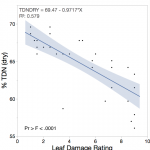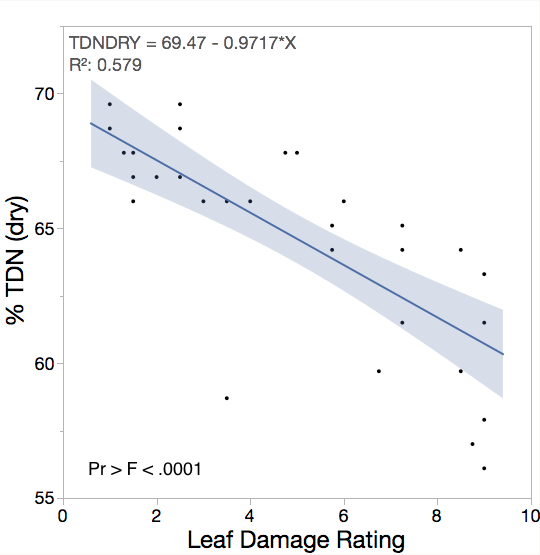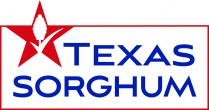Sugarcane Aphid and Grazing Grain Sorghum Stalks—In the sorghum belt following grain harvest, some growers will elect to graze their sorghum stalks during the early fall and winter. Sugarcane aphids, if not properly controlled, can cause severe injury to the sorghum plant. Many have asked how much this injury reduces the feeding value of sorghum stover. In 2016, entomologists Pat Porter, Blayne Reed and Katelyn Kowles at Texas AgriLilfe were able to conduct trials to examine the quality of sorghum stover that had suffered different levels of injury from the sugarcane aphid. By controlling aphids with insecticides at different infestation levels, the entomologists were able to create different levels of crop injury. Crop injury ranged from very little to severe plant damage caused by the sugarcane aphid. Crop injury was rated using a scale of zero to ten, with ten representing 91 to 100 percent leaf area damage or dead plants. Following grain harvest, stover was sent to Servi-Tech labs for quality analysis. A more detailed description of how the trials were conducted, as well as various graphs of the nutrient analysis, was reported in Texas Sugarcane Aphid News on Dec. 9th.
Results and Interpretation:
Not surprisingly, the quality of the stover did decrease with increased plant damage caused by the sugarcane aphid (see attached TDN graph). However, the drop in quality was not as much as one might have expected. Percent acid detergent fiber (ADF) increased from approximately 29 to 37.5 percent, total digestible nutrients (TDN) decreased from 68.5 to 60 percent and digestible energy decreased from 1.4 to 1.21 Mcal/lb dry forage. There was a trend for crude protein to decrease but the correlation with plant injury was poor. It is important to note that even though the sugarcane aphid did reduce the quality of the sorghum stover, the overall quality remained good. Even at the highest plant damage rating, the stover quality was comparable to most sorghum hay. For comparison, the average percent ADF was 34.8 and TDN was 65.9 in a forage sorghum hay trial conducted by Texas AgriLife near Amarillo, TX, in 2010 (Texas AgriLife Variety Testing). In reviewing the data with Dr. Ted McCollum, Texas AgriLife beef cattle nutritionist, he said that forage with a TDN value of 60 or greater is more than adequate for beef cows in late gestation and early lactation. For stocker cattle, Dr. McCollum indicated that a TDN value of 60 will project to a daily gain of about 1.4 lb/day gain while a 67 percent TDN will project over 2 lb/day gain. He also stated that protein supplement is necessary when grazing sorghum stover regardless of any sugarcane aphid damage. There has also been concern that the sooty mold that often grows on the dried sorghum leaves that were infested by sugarcane aphids might be toxic to cattle. Initial testing of the mold by Kansas State (personal communication) has shown this to be a common non-toxic mold. Please contact Brent Bean at brentb@sorghumcheckoff.com with any comments or questions.
Indemnity Fund Update—Texas Department of Ag has delayed ballot counting for the indemnity fund vote until Wednesday, Dec. 23. Some of the ballot boxes had not been received as of Friday.
Shareowners Approve Monsanto Merger with Bayer—Monsanto shareholders approved the merger with Bayer CropScience during a special meeting on Dec. 13, 2016. Under the agreement, at the closing of the merger currently expected by the end of 2017, Monsanto shareholders will receive $128 per share in cash. To read more on the merger, click here.
Export Report—Sorghum continued strong sales last week with a total of 10.2 million bushels. China led the export commitments with 8.2 million bushels. These sales bring total commitments for the current marketing year to 114.73 million bushels.










